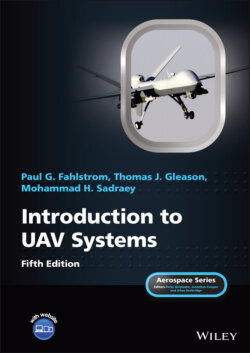Читать книгу Introduction to UAV Systems - Mohammad H. Sadraey - Страница 17
1.2 History 1.2.1 Early History
ОглавлениеThroughout their history, UAV systems have tended to be driven by military applications, as is true of many areas of technology, with civilian applications tending to follow once the development and testing had been accomplished in the military arena.
One could say that the first UAV was a stone thrown by a caveman in prehistoric times or perhaps a Chinese rocket launched in the thirteenth century. These “vehicles” had little or no control and essentially followed a ballistic trajectory. If we restrict ourselves to vehicles that generate aerodynamic lift and/or have a modicum of control, the kite would probably fit the definition of the first UAV.
In 1883, an Englishman named Douglas Archibald attached an anemometer to the line of a kite and measured wind velocity at altitudes up to 1,200 ft. Mr. Archibald attached cameras to kites in 1887, providing one of the world’s first reconnaissance UAVs. William Eddy took hundreds of photographs from kites during the Spanish–American war, which may have been one of the first uses of UAVs in combat.
It was not until World War I, however, that UAVs became recognized systems. Charles Kettering (of General Motors fame) developed a biplane UAV for the Army Signal Corps. It took about 3 years to develop and was called the Kettering Aerial Torpedo, but is better known as the “Kettering Bug” or just plain “Bug.” The Bug could fly nearly 40 mi at 55 mi/h and carry 180 lb of high explosives. The air vehicle was guided to the target by pre‐set controls and had detachable wings that were released when over the target, allowing the fuselage to plunge to the ground as a bomb. Also, in 1917, Lawrence Sperry developed a UAV, similar to Kettering’s, for the Navy, called the Sperry‐Curtis Aerial Torpedo. It made several successful flights out of Sperry’s Long Island airfield, but was not used in the war.
We often hear of the UAV pioneers who developed the early aircraft, but other pioneers were instrumental in inventing or developing important parts of the system. One was Archibald Montgomery Low, who developed data links. Professor Low, born in England in 1888, was known as the “Father of Radio Guidance Systems.” He developed the first data link and solved interference problems caused by the UAV engine. His first UAVs crashed, but on September 3, 1924, he made the world’s first successful radio‐controlled flight. He was a prolific writer and inventor and died in 1956.
In 1933, the British flew three refurbished Fairey Queen biplanes by remote control from a ship. Two crashed, but the third flew successfully, making Great Britain the first country to fully appreciate the value of UAVs, especially after they decided to use one as a target and couldn’t shoot it down.
In 1937 another Englishman, Reginald Leigh Denny, and two Americans, Walter Righter and Kenneth Case, developed a series of UAVs called RP‐1, RP‐2, RP‐3, and RP‐4. They formed a company in 1939 called the Radioplane Company, which later became part of the Northrop‐Ventura Division. Radioplane built thousands of target drones during World War II. (One of their early assemblers was Norma Jean Daugherty, later known as Marilyn Monroe.) Of course, the Germans used lethal UAVs (V‐1’s and V‐2’s) during the later years of the war, but it was not until the Vietnam War era that UAVs were successfully used for reconnaissance.
